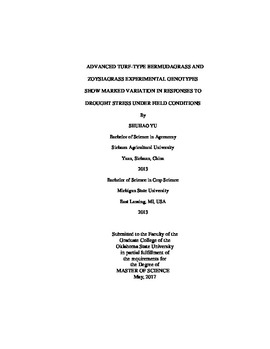| dc.description.abstract | Bermudagrasses (Cynodon spps.) and zoysiagrasses (Zoysia spps.) are the most commonly used warm-season turfgrasses in the southern and transition zone areas of the United States. It is important to improve turfgrass drought resistance for water savings and persistence under drought stress. A number of experimental and commercially available turf bermudagrasses and zoysiagrasses were evaluated for drought response at the Oklahoma State University Turfgrass Research Center in Stillwater, Oklahoma during 2016. The trials were designed as randomized complete blocks with four replications for the zoysiagrass and one of the bermudagrass trials and three replications on another bermudagrass trial. Following a one-year period of establishing under regular irrigation, all trials were maintained under no irrigation and no rainfall upon the start of a dry down cycle. Polyethylene waterproof tarps were used to exclude rainfall from each trial. Entries were evaluated for turf quality (TQ), leaf firing (LF), normalized difference vegetation index (NDVI) and live green cover (LGC) at least once each week during the dry down cycle. Turf quality, LF, NDVI, and LGC were positive and highly correlated, suggesting that they were effective indicators for characterizing turfgrass drought response. Mean volumetric soil water content (MVSWC) had a positive and low to moderate correlation to LF, TQ, NDVI and LGC. Days after starting drought treatment (DAT) had a negative and moderate to high correlation to TQ, LF, NDVI, LGC and MVSWC. As DAT increased, all the testing parameters had decreased. �TifTuf� bermudagrass had the highest rating of all parameters (indicating best drought response) on most dates during severe drought. �OSU1221� bermudagrass provided better performance than other experimental genotypes on most dates during severe drought. All bermudagrass experimental genotypes showed equal or improved performance with respect to drought response than the standard �Tifway� during most dates under severe drought. �DALZ1411� had the overall best performance on all four parameters among all the zoysiagrass entries. Zoysiagrass standards �Empire�, �Zeon�, and �Palisade� were not as drought resistant as most of the experimental genotypes. All zoysiagrass experimental genotypes except �FZ1223� showed improvement in drought response over all standards. | |
